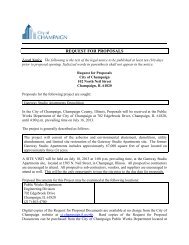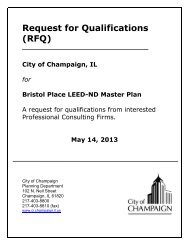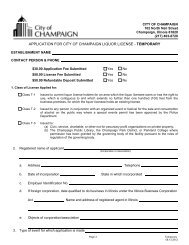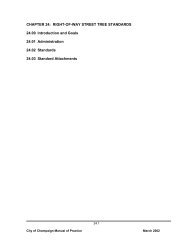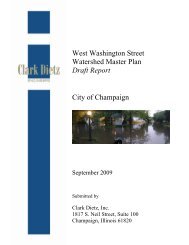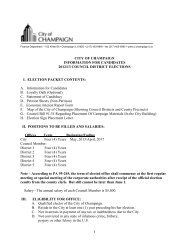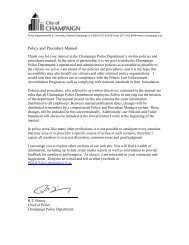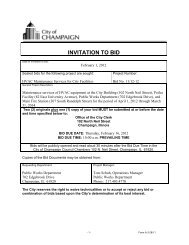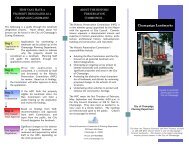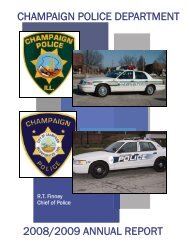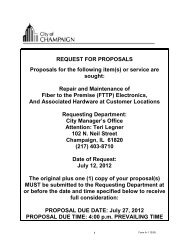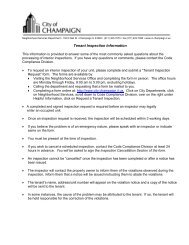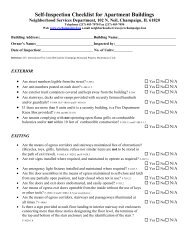2010-2014 Consolidated Plan - City of Champaign
2010-2014 Consolidated Plan - City of Champaign
2010-2014 Consolidated Plan - City of Champaign
Create successful ePaper yourself
Turn your PDF publications into a flip-book with our unique Google optimized e-Paper software.
Because the cost <strong>of</strong> homeownership is so high, many low-income households find it difficult to save forhome repairs. In <strong>Champaign</strong>, the lowest income neighborhoods contain some <strong>of</strong> the oldest housing stockin the <strong>City</strong>. Keeping older homes in good condition requires a periodic investment in homeimprovements. For this reason, the <strong>City</strong> <strong>of</strong> <strong>Champaign</strong> continues to see a high demand for housingassistance programs from homeowners in this income range.Low-Income (51-80% MFI)In this income group, 35 percent <strong>of</strong> the 1,917 households reported having housing problems with 33percent reporting a housing cost burden. Low income owners are experiencing housing problems, but toa lesser extent than extremely low-income and very-income households. During the first four years <strong>of</strong>the 2005-2009 <strong>Consolidated</strong> <strong>Plan</strong> period, 72 households, or 28 percent <strong>of</strong> all households served were inthe low-income category. Because <strong>Champaign</strong>’s program leverages private loan funding for householdsin this income group, credit problems tend to eliminate some households from participation. In recentyears, the lack <strong>of</strong> sufficient equity also prevents persons from being approved, as lower interest rateshave encouraged many households to consolidate consumer debt through home loan refinancing.Housing values are not increasing during the current housing market which has also impacted equity inthe homes. Under the current economic climate, those households that do get approved for a loan arenot willing to take on additional debt at this time.Needs <strong>of</strong> Homeowners: By Household Type and Race/EthnicityElderly HouseholdsThere are 254 extremely low-income (< 30% MFI) elderly homeowners living in <strong>Champaign</strong> and another415 with incomes between 31-50% MFI. According to 2000 Census data, 28% <strong>of</strong> elderly householdshave incomes less than 50% MFI. Nine out <strong>of</strong> ten elderly owners with incomes less than 30% MFI arehousing cost burdened. This is up from 79% in 1990. Low-income homeowners in this age group arevery vulnerable to housingTable 3-2: Elderly Homeowners and Housing Problems, <strong>City</strong> <strong>of</strong> <strong>Champaign</strong>1990-2000Elderly Homeowners 1990 2000Extremely low-income (0 to 30% MFI) 263 254% with any housing problem 79% 91%% with cost burden > 30% 77% 91%% with cost burden > 50% 36% 55%Low-income (31% to 50% MFI) 435 415% with any housing problem 40% 44%% with cost burden > 30% 40% 44%% with cost burden > 50% 8% 11%Moderate-income (51% to 80% MFI) 522 549% with any housing problem 14% 18%% with cost burden > 30% 14% 18%% with cost burden > 50% 2% 2%Total Households 2,916 3,478% with any housing problem 16% 15%Source: HUD CHAS Tables, U.S. Censusproblems and excessive costburden, and this problem isworsening. Because thefastest growing segment <strong>of</strong> thepopulation is over 80 years old,this trend is likely continue intothe future. Households livingon fixed incomes, whichinclude many elderlyhouseholds, are <strong>of</strong>ten unableto manage the rising costs <strong>of</strong>homeownership. Activities likethe Senior Home Repairprogram are likely to be ineven greater demand throughthe duration <strong>of</strong> this five-yearplan.24 Needs Assessment: Housing and Homelessness



